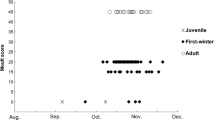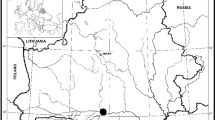Abstract
Moult is an extremely time-consuming and energy-demanding task for large birds. In addition, there is a trade-off between the time devoted to moulting and that invested in other activities such as breeding and/or territory exploration. Moreover, it takes a long time to grow a long feather in large birds, and large birds that need to fly while moulting cannot tolerate large gaps in the wing, but only one or two simultaneously growing feathers. As a consequence, large birds take several years to complete a full moult cycle, and they resume the moult process during suboptimal conditions. A clear example of this pattern is the Bearded Vulture (Gypaetus barbatus), which needs 2–3 years for changing all flight feathers. Here we describe the sequence, extent, and timing of moult of 124 Bearded Vultures in detail for the first time. We found that extent and timing of flight feather moult was different between age classes. Subadults (from 3rd to 5th calendar year) started moult, on average, in early March, whereas adults only started moult, on average, in late April, possibly due to breeding requirements. Second calendar year individuals delayed onset of moult until the middle of May. In general, the moult lasted until November, and although adults started to moult later than subadults, they moulted more feathers. Subadults needed 3 years for moulting all flight feathers, whereas adults normally completed it in 2 years.
Zusammenfassung
Die Flugfedermauser beim Bartgeier
Die Mauser ist ein extrem zeit- und energieaufwändiger Vorgang für große Vögel. Darüber hinaus gibt es einen Konflikt zwischen der Zeit, die für die Mauser aufgebracht wird und derjenigen, die in andere Aktivitäten investiert werden kann, so wie Brüten oder territoriale Exploration. Außerdem braucht das Wachstum einer langen Feder bei großen Vögeln lange; und große Vögel, die darauf angewiesen sind während der Mauser zu fliegen, können sich keine größeren Lücken in den Flügeln leisten, sondern nur ein oder zwei gleichzeitig nachwachsende Federn. Als Konsequenz braucht es mehrere Jahre, bis große Vögel einen vollen Mauserzyklus vollendet haben, und sie nehmen die Mauser unter suboptimalen Bedingungen wieder auf. Ein deutliches Beispiel für dieses Muster ist der Bartgeier (Gypaetus barbatus), der zwei bis drei Jahre braucht für einen kompletten Wechsel seiner Flugfedern. Hier beschreiben wir zum ersten Mal im Detail die Abfolge, das Ausmaß und das Timing der Mauser von 124 Bartgeiern. Wir fanden, dass Ausmaß und Timing der Flugfedermauser sich zwischen Altersklassen unterschied. Subadulte (vom dritten bis fünften Kalenderjahr) begannen die Mauser, im Durchschnitt, im frühen März, während die Mauser der Adulten im Durchschnitt erst im späten April begann, möglicherweise aufgrund von Zwängen im Zusammenhang mit der Brut. Individuen im zweiten Kalenderjahr verzögerten den Beginn der Mauser bis Mitte Mai. Generell dauerte die Mauser bis November, und obwohl Adulte mit der Mauser später begannen als Subadulte, mauserten sie mehr Federn. Subadulte brauchten drei Jahre zur Mauser sämtlicher Flugfedern, während dagegen Adulte normalerweise in zwei Jahren fertig waren.




Similar content being viewed by others
References
Adam A, Llopis A (2003) The Bearded vulture (Gypaetus barbatus): age features and moult process. Taller de Ecología—Ecologistas en Acción, Linares, Madrid
Antor RJ, Margalida A, Heredia R (2005) Quebrantahuesos. Gypaetus barbatus. In: Madroño A, González C, Atienza JC (eds) Libro rojo de las aves de España. Dirección General para la Biodiversidad-SEO/BirdLife, Madrid, pp 125–129
Barshep Y, Minton CDT, Underhill LG, Erni B, Tomkovich P (2013) Flexibility and constraints in the moult schedule of long-distance migratory shorebirds: causes and consequences. Ecol Evol 3(7):1967–1976
Brommer JE, Pihlajamäki O, Kolunen H, Pietiäinen H (2003) Life-history consequences of partial-moult asymmetry. J Anim Ecol 72:1057–1063
Burnham KP, Anderson (2002) Model selection and multimodel inference. A practical information-theoretic approach, 2nd edn. Springer, New York
Calder WAI (1984) Size, function, and life history. Harvard University Press, Cambridge
Chandler RM, Pyle P, Flannery ME, Long DJ, Howell SG (2010) Flight feather molt of turkey vultures. Wilson J Ornithol 122:254–260
Cieslak M, Bolestaw D (2006) Feathers identification for bird conservation. Natura Publishing House, Warsaw
Clark WS (2004) Wave molt of the primaries of Accipitrid raptors, and its use in ageing. In: Chancellor RD, Meyburg B-U (eds) Raptors worldwide: proceedings of the VI world conference on birds of prey. World Working Group on Birds of Prey, Berlin, pp 795–804
Daunt F, Wanless S, Harris MP, Money L, Monaghan P (2007) Older and wiser: improvements in breeding success are linked to better foraging performance in European shags. Funct Ecol 21:561–567
Dietz MW, Rogers KG, Piersma T (2013) When the seasons don’t fit: speedy Molt as a routine carry-over cost of reproduction. PLoS One 8(1):e53890. doi:10.1371/journal.pone.0053890
Edelstam C (1984) Patterns of moult in large birds of prey. Ann Zool Fenn 21:271–276
Erni B, Oschadleus HD, Bonnevie B, Altwegg R, Underhill LG (2013) Moult: an R-package to analyse moult in birds. J Stat Soft 52:1–23
Espie RHM, Oliphant LW, James PC, Warkentin IG, Lieske DJ (2000) Age-dependent breeding performance in Merlins (Falco columbarius). Ecology 81:3404–3415
Foster MS (1975) The overlap of molting and breeding in some tropical birds. Condor 77:304–314
Gil JA (2012). Quebrantahuesos, Gypaetus barbatus. In: SEO/BirdLife. Atlas de las aves en invierno en España 2007–2010. Ministerio de Agricultura, Alimentación y Medio Ambiente-SEO/BirdLife, Madrid, pp166–167
Gil JA, Díez O, Báguena G, Lorente L, Pérez C, Losada JA, Alcántara M (2010) Juvenile dispersal of the Bearded vulture (Gypaetus barbatus) in the Pyrenees (Spain-France). Fundación para la Conservación del Quebrantahuesos (FCQ), Zaragoza
Gil JA, Báguena G, Sánchez-Castilla E, Antor RJ, Alcántara M, López-López P (2014) Home range and movements of non-breeding Bearded vultures tracked by satellite telemetry in the Pyrenees. Ardeola 61(2):379–387
Ginn HB, Melville DS (2000) Moult in birds. BTO Guide 19. In: Norwich UK, Hammer O (eds) 2011. PAST PAleontological STAtistics. Version 2.1. reference manual. Natural History Museum, University of Oslo, Oslo
Hedenström A (2006) Scaling of migration and the annual cycle of birds. Ardea 94:399–408
Hemborg C, Lundberg A (1998) Costs of overlapping reproduction and moult in passerine birds: an experiment with the Pied Flycatcher. Behav Ecol Sociob 43:19–23
Herremans M (2000) The “chaotic” flight feather moult of the Steppe buzzard buteo buteo vulpinus. Bird Study 47:332–343
Hickman CP, Roberts LS, Larson A (1993) Integrated principles of zoology. Mosby, St Louis
Hiraldo F, Delibes M, Calderón J (1979) El Quebrantahuesos Gypaetus barbatus (L.). Sistemática, taxonomía, biología, distribución y protección. Monografías 22. Instituto Nacional para la Conservación de la Naturaleza, Madrid
Houston DC (1975) The moult of the white-backed and Rüppell`s Griffon vultures Gyps africanus and G. rueppellii. Ibis 117:474–488
Langston NE, Rohwer S (1995) Unusual patterns of incomplete primary molt in laysan and black-footed albatrosses. Condor 97:1–19
López-López P, Zuberogoitia I, Alcantara M, Gil JA (2013) Philopatry, natal dispersal, first settlement and age of first breeding of Bearded Vultures Gypaetus barbatus in central Pyrenees. Bird Study 60:555–560
López-López P, Gil JA, Alcántara M (2014) Post-fledging dependence period and onset of natal dispersal in Bearded vultures (Gypaetus barbatus) : new insights from GPS satellite telemetry. J Raptor Res 48:173–181
Margalida A (2011). Quebrantahuesos—Gypaetus barbatus. In: Salvador A, Bautista LM (eds) Enciclopedia Virtual de los Vertebrados Españoles. Museo Nacional de Ciencias Naturales, Madrid. http://www.vertebradosibericos.org/
Margalida A, García D, Bertran J, Heredia R (2005) Biología de la reproducción del quebrantahuesos en los Pirineos. In: Margalida A, Heredia R (eds) Biología de la Conservación del Quebrantahuesos (Gypaetus barbatus) en España. Serie técnica, Organismo Autónomo Parques Nacionales, Ministerio de Medio Ambiente, Madrid, pp 279–304
Margalida A, Carrete M, Hegglin D, Serrano D, Arenas R, Donázar JA (2013) Uneven large-scale movement patterns in wild and reintroduced pre-adult bearded vultures: conservation implications. PLoS One 8(6):e65857. doi:10.1371/journal.pone.0065857
Mundy PJ (1982) The comparative biology of southern African vultures. Vulture Study Group, Johannesburg
Newton I (2009) Moult plumage. Ring Migrat 24:220–226
Penteriani V, Rutz C, Kenward R (2013) Hunting behaviour and breeding performance of northern goshawks accipiter gentilis, in relation to resource availability, sex, age and morphology. Naturwissenschaften 100:935–942
Pietiäinen H, Saurola P, Kolunen H (1984) The reproductive constraints on moult in the ural owl strix uralensis. Ann Zool Fenn 21:277–281
Pyle P (2005) Remigial molt patterns in North American falconiformes as related to age, sex, breeding status, and life-history strategies. Condor 107:823–834
Pyle P (2006) Staffelmauser and other adaptative strategies for wing molt in larger birds. Western Birds 37:179–185
R Core Team (2014) R: a language and environment for statistical computing. R Foundation for Statistical Computing, Vienna, Austria. http://www.R-project.org/
Rohwer VG, Rohwer S (2013) How do birds adjust the time required to replace their flight feathers? Auk 130:699–707
Rohwer S, Ricklefs RE, Rohwer VG, Copple MM (2009) Allometry of the duration of flight feather molt in birds. PLoS Biol 7(6):e1000132. doi:10.1371/journal.pbio.1000132
Rohwer S, Viggiano A, Marzluff JM (2011) Reciprocal tradeoffs between molt and breeding in albatrosses. Condor 113:61–70
Sesé JA (2011) Los plumajes del Quebrantahuesos. In: Lacasa M (ed) El libro de las rapaces. Photodigiscoping S.C.P, Barcelona, pp 10–25
Snyder NFR, Johnson EV, Clendenen DA (1987) Primary molt of California Condors. Condor 89:468–485
Stresemann E, Stresemann V (1966) Die Mauser der Vögel. J für Ornitholo 107:1–448
Underhill LG, Zucchini W (1988) A model for avian primary moult. Ibis 130:358–372
Underhill LG, Zucchini W, Summers RW (1990) A model for avian primary moult-data types based on migration strategies and an example using the redshank Tringa totanus. Ibis 132:118–123
Zuberogoitia I, Martínez JA, Zabala J, Martínez JE, Castillo I, Hidalgo S (2005) Sexing, ageing and moult of common buzzards buteo buteo in a southern Europe area. Ring Migrat 22:153–158
Zuberogoitia I, De la Puente J, Elorriaga J, Alonso R, Palomares LE, Martínez JE (2013a) The flight feathers molt of griffon vultures Gyps fulvus and associated biological consequences. J Rapt Res 47(3):292–303
Zuberogoitia I, González-Oreja JA, Martínez JE, Zabala J, Gómez I, López-López P (2013b) Foraging movements of Eurasian Griffon Vultures (Gyps fulvus): implications for supplementary feeding management. European J Wildl Res 59:421–429
Acknowledgments
This paper has been developed under the agreement signed by the Foundation for the Conservation of the Bearded Vulture (FCQ), Aragón regional government and the Spanish Ministry of Environment, under the actions of the Bearded Vulture Recovery Plan in Aragón and the Bearded Vulture Reintroduction Program in Picos de Europa. We are indebted to the Departamento de Agricultura, Ganadería y Medio Ambiente (Aragón regional government), European Union (LIFE 1998–2006, and INTERREG IIIA 2002–2006 programs), MIMAM (Spain), Guardia Civil (GREIM), Aragón Forest Rangers (APN), Wildlife Rehabilitation Centre at La Alfranca (Zaragoza), LVFS, IREC-CSIC, EBD-CSIC, SEO/BirdLife, “Aragón” Ringing Group, Trango, Zeiss and Land Rover. Thanks to J Guiral, J Insausti and M. Alcantara. G. González, I. Otra, J. Serra, J. Sánchez, J. Marti, S. Marcedos, J. Vecino, D. Forsman, for sharing with us their picture collections of Bearded Vultures. L Palomares helped us drawing the Fig. 4. Special thanks are due to all the members of the FCQ and particularly to O Díez, G Baguena, L Lorente, R Antor, G Chéliz, JC Ascaso and JC Gonzalez. Two anonymous reviewers provided helpful comments on the manuscript. This paper complies with the current laws in Spain. The authors declare that no conflict of interest exists.
Author information
Authors and Affiliations
Corresponding author
Additional information
Communicated by F. Bairlein.
Rights and permissions
About this article
Cite this article
Zuberogoitia, I., Gil, J.A., Martínez, J.E. et al. The flight feather moult pattern of the bearded vulture (Gypaetus barbatus). J Ornithol 157, 209–217 (2016). https://doi.org/10.1007/s10336-015-1269-3
Received:
Revised:
Accepted:
Published:
Issue Date:
DOI: https://doi.org/10.1007/s10336-015-1269-3




